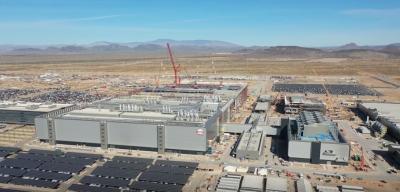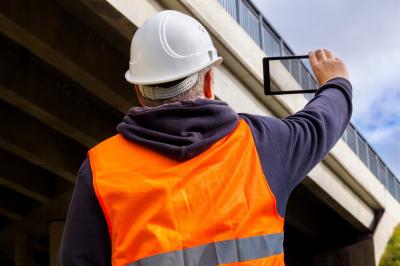Auto and pedestrian bridges will be replaced as part of a $125.6 million, Grand Avenue Bridge construction project near Glenwood Springs and Interstate 70 in western Colorado.
Auto and pedestrian bridges will be replaced as part of a $125.6 million, Grand Avenue Bridge construction project near Glenwood Springs and Interstate 70 in western Colorado.
It's the largest infrastructure project in western Colorado in more than 25 years.
The 1,000-ft. (304.8 m) Grand Avenue Bridge and nearby 600-ft. (183 m) pedestrian bridge serve as a vital connection between downtown Glenwood Springs, the historic Glenwood Hot Springs district and Interstate 70. The 30-month project will address the functional and structural deficiencies of the current bridge including emergency service response and reliability as a critical transportation route.
The Grand Avenue Bridge was built in 1953 as a two-lane bridge with sidewalks on either side. It had an anticipated 50 to 60 year lifespan.
The new pedestrian bridge is expected to be ready for use in February 2017.
The bridge project began in January. The estimated completion date for the vehicle bridge is July 1, 2018.
Granite/RLW joint venture is contractor for the project. The joint venture is comprised of Granite Construction Inc. and Ralph L. Wadsworth Construction Co.
CDOT selected the contractor through a construction management/general contractor method.
“This allowed the contractor to come onto the project early during the design phase to assist with cost estimating and constructability issues,” said Tom Newland, CDOT public information manager for the Grand Avenue Bridge project.
Along with $68.4 million for construction, right-of-way acquisition, utilities, design and environmental studies added an additional $57.2 million onto the project cost.
Tsiouvaras Simmons Holderness of Greenwood Village, Colo., designed the vehicle bridge. AMC Foster Wheeler of Denver designed the pedestrian bridge.
Subcontractors for the project include SGM for surveying; Gould Construction for roadway and wet utilities; United Companies for aggregate; Cal-X Minerals for rock and permanent rip rap; Grand River Construction for asphalt paving; and S2M for flatwork and concrete paving. All six companies are located in Glenwood Springs.
Pioneer Steel Inc. of nearby New Castle, Colo., is in charge of steel erection.
Between 20 and 100 workers are working on the Grand Avenue Bridge project each day.
Funding for the project is provided through Colorado Bridge Enterprise formed in 2009 as part of Colorado's Funding Advancement for Surface Transportation and Economic Recovery (FASTER) legislation. It operates as a government-owned business within the Colorado Department of Transportation.
The bridge will be constructed in five phases. Phase 1 has been completed. It included work on the southern causeway on the south riverbank to make it easier to access the bridge piers.
Crews also installed a temporary walkway on the current traffic bridge.
Workers constructed a cul-de-sac at the west end of the Glenwood Hot Springs parking lot to provide a turnaround for shuttle parking.
Phase 2 is underway and includes removal of the pedestrian bridge.
The existing pedestrian bridge was designed so it could be taken apart and rebuilt at another location. As a city-owned bridge, it can be stored by the city until it is needed somewhere else.
Phase 2 work also includes construction of roadways and walls of River Road, the bridge approach and some of the I-70 westbound off-ramp. Workers also will install caissons and begin substructure work.
“Piers for the pedestrian bridge will be poured this month or next,” Newland said.
Phase 3 will include removal of Union Pacific Railroad spur tracks; construction of the 8th Street connection; replacement of the existing rail on the bridge; intersection improvements; widening of Exit 114 ramps on I-70; and reconstruction of roundabouts. Phase 3 should conclude in August 2017.
Phase 4 will include demolition of the old vehicle bridge; construction of a parking lot; and completion of the new bridge.
Phase 5 features construction of an I-70 eastbound onramp; removal of the causeways down to the piers; construction of a retaining wall for eastbound I-70 off-ramp; and completion of roadway electrical work.
Extensive Use of Asphalt, Concrete
Crews will apply 3,375 tons (3061.7 t) of asphalt and 21,398 tons (19,412 t) of concrete. Concrete will be used in both paving and structural applications.
Other materials include steel beams, veneer stone and brick finishes.
Currently several large cranes are on site along with earthmoving equipment.
A Causeway Will Be Built
Granite/RLW joint venture is building a causeway in the form of a temporary rock road along the Colorado River bank. It will be used as a working platform.
A causeway is needed to create closer access to the bridge. It is roughly 500 ft. (152.4 m) long and 50 to 75 ft. (15.24 to 23 m) wide.
The causeway will be removed when the project is complete. Cranes, drills and trucks will use the causeway as a staging point.
The contractor also is installing a storm drain line and a permanent water line. Utility work begins along the north lane of 7th Street between Colorado and Cooper avenues.
In addition, Granite/RLW joint venture will begin excavation work for building the substructure at the pier between the railroad tracks and 7th Street.
Reasons for Bridge Replacement
The bridge is considered functionally and structurally obsolete. It has narrow lane widths and substandard vertical and horizontal clearances.
In addition, the piers are supported by shallow spread footings and are susceptible to scour and erosion.
Load capacity also is a problem. The carrying capacity is 55 percent of current standards. Finally, the bridge is showing signs of deterioration.
Positive Impacts
Newland pointed out that the project is not aimed at solving traffic congestion.
“It is strictly a bridge replacement project,” he said. “Replacing the vehicle bridge can definitely be seen as mitigating safety concerns.”
Newland added that great care has been taken to ensure the new bridges have been designed to fit within the context of the Glenwood Springs downtown area.
“The design includes finishes that replicate the look and feel of the surrounding buildings, in particular the historic hot springs bath house and Union Pacific train station.”
The vehicle bridge also is designed to provide improved access to downtown Glenwood Springs and the Roaring Fork Valley, known for Aspen and Snowmass ski resorts.
“Glenwood's hot springs and downtown, as well as the Aspen area are very popular tourist destinations with annual visitor days running into the millions,” Newland said.
The new bridge alignment also will provide the opportunity for the town to expand its downtown area north in the vicinity of the hot springs.
Traffic Impacts
Exit 116 (main Glenwood Springs to Aspen exit) westbound off-ramp is in a one-lane configuration. The one-lane closure is necessary for a storm drain utility project.
Both lanes of 7th Street from Colorado Avenue to Cooper Avenue are closed to traffic. Heavy equipment and construction vehicles are under the Grand Avenue Bridge for the 7th Street utility project.
Access to River Street from Laurel Street is restricted to construction traffic only. Access from the Historic Hot Springs District remains open.
Interstate 70 eastbound Exit 116 is reduced to one lane of traffic for approximately 2,000 ft. (609.6 m). This will be the condition for throughout Phase 2. The speed limit has been reduced to 40 mph in this area.
Project Challenges
So far the project has proceeded as expected. But weather can be a problem especially during winter months.
“Weather in the Rocky Mountains is always a factor that can impact the project schedule,” Newland said.
Today's top stories




















